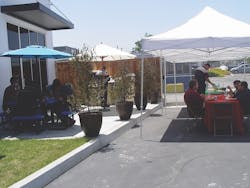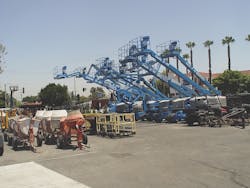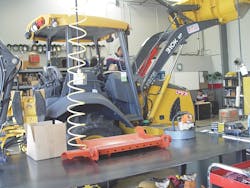Tony Murray never set out to be an environmental pioneer. He just wanted to run a profitable growing equipment rental business. But as many rental professionals have found, sometimes finding a location is the most daunting aspect of trying to open a new rental business or expand to a new location. Finding a facility that could work in an area zoned correctly for a rental center with trucks and fuels and sometimes middle-of-the-night activity is often close to impossible.
While in some cities finding suitable property is not as difficult as populations expand in large geographic areas with spacious industrial parks, in dense southern California it’s another story. When Murray needed to move from the Bellflower branch of his three-location rental company American Rentals, it was very hard to find a properly zoned property. In fact, Murray says, during a recent meeting with his real estate agent, he was told there were three available properties in Los Angeles, which covers more than 4,700 square miles.
Knowing that the Bellflower lease would be up at the end of 2014, Murray spent a year searching before finding a property in North Long Beach that seemed like the perfect location for American Rentals. The location is also strategically placed with access to nearby freeways such as Interstates 405, 91, 710, 105 and 110.
“It took us a year to find a piece of property,” Murray recalls. “Anyplace we would find that we thought would work, the city didn’t want us. They just don’t want rental yards. It was very, very difficult. We looked at every property, every option. We were almost giving up; I thought we were going to have to lease something somewhere when we found this place.”
The property Murray eventually purchased was in the city of Long Beach. It was known as the ‘greenest’ city in the area and Murray initially thought there was no real chance they would want a rental business on a prominent corner. But he found the city more receptive than he expected and he was able to purchase the property and obtain the business license. But little did he know the challenges were just beginning.
“We purchased an undeveloped vacant lot,” Murray says. “It had no fence, no driveway and no utilities. The utilities were the hardest. We had to bring in underground phone and Internet lines, water and sewer service, and, in addition, we had to bring in our own fire lines with hydrants and power. This meant working with [utility Southern California Edison] to add a pole on our property and a 16,000 volt transformer. There was not even an address here. Getting utilities to a piece of property that doesn’t have an address, it’s like no-man’s land, is almost impossible.”
The move itself went smoothly. The company moved April 1, 2014, over a weekend. “We never lost one phone call, never lost any business,” Murray says. “Hugo (branch manager Hugo Nuñez) and I spent months planning for every scenario that could go wrong.”
Eventually utilities and phone service were arranged. The company moved into two temporary trailers and put up two big tents, one for the party side of the business and another for the mechanics. The company was able to use water from the neighboring building and used portable toilets while the construction was in process.
“Our staff was incredibly patient to put up with it,” Murray says of the temporary makeshift working arrangements. “We closed escrow on June 15th [2014] and we started building on June 16th. We spent all of our previous time getting our plans together, getting everything done and we acted as the general. We poured the slabs over July 4th weekend and we finished the building around December, we moved in right before Christmas.”
Still, a week after setting up the trailers, the city came out and wanted to shut the business down because it didn’t supply handicap access to its temporary trailer. “I didn’t know; how would I know?” Murray recalls. “I said ‘I’ll do it, it will be in by Monday.’ this was a Thursday. I said ‘Give me one day to comply, be reasonable, we’re reasonable people.’”
Murray says that during 11 years of doing business, he’d never had a handicapped person come to rent equipment, so it didn’t occur to him to provide access. Not only did American Rentals provide the necessary access, but as it built the new facility, all five restrooms were equipped according to Americans with Disabilities Act specifications.
But the biggest challenge was LEED certification required by the city of Long Beach. LEED, which stands for Leadership in Energy and Environmental Design, is a rating system that measures the design, construction and operation of high-performance green buildings, homes and neighborhoods, developed by the U.S. Green Building Council to guide the building industry and provide standards for sustainability for a variety of building projects.
“The city of Long Beach wants everything [larger than 7,500 square feet] to be LEED-certified,” Murray says. “So everything, every faucet, every light fixture, everything is all low energy.”
However, Murray found there was no real guidebook to explain how to build according to LEED specifications.
“Hugo and I were working 16-, 17-hour days,” he says. “We’d spend late, late nights trying to figure it out and then spend all day building. And run a rental business at the same time. So we tried to run the business during the day and at night we were working on this. Many many late nights looking at this and thinking ‘what did we get ourselves into?’ ”
Every time something was built or installed, Murray would have to certify that it was at code. “We learned a lot of things we didn’t know,” he says. “Every day was something we didn’t know. How would we possibly know all these things?”
“The LEED process is strenuous, everything has to be well-thought-out and planned ahead,” Nuñez says.
The lighting all had to be LED and other low-energy lighting, equipped with motion sensors so the lights would turn off when a person left the room. The windows had to be dual-glazed and meet a certain rating for energy efficiency. Every place where ducting was put in had to be perfectly sealed and dustproofed according to code. The entire building has fire sprinklers. Because the roof emits heat, a certain quantity of trees had to be planted to counteract the heat and provide shade.
“We had to prove that we recycled every bit of building debris,” Murray adds. “Everything had to be recycled and we had to prove it with receipts for every bit of debris that came off this jobsite. Metal, dirt, asphalt, concrete, cardboard, steel, whatever it was, had to go to the appropriate recycler. And the city held the deposit, $25,000, until we could prove that we recycled everything and then they gave the deposit back.”
“This is an asphalt parking lot,” adds Nuñez. “They pulverized it, they ground it up, and we used it as part of our base materials for when we compacted.”
At every step, a civil engineer would come out from the city and test it, or observe while American’s staff tested it. Finally after every step passed, Murray and staff received a certificate of occupancy the day after Christmas 2014.
“That was a great present,” he says. “It was a great feeling to be done.”
Despite the challenges, the American staff came in on budget and ahead of schedule. “We worked incredibly hard to save every dollar,” Murray says. “So when Edison said ‘I need a 300-foot trench six feet deep here to put our power line in,’ we have the equipment so we would literally dig those ourselves and have [the utility] come out to pipe it and then we’d fill it back in and compact it. So we did everything that we thought we could do and save money on and yet I don’t think we spared any expense on making it nice and what we wanted. It was a trade-off. We could have gotten cheaper windows that weren’t tinted, and we’re going to have to polish the concrete floors, and we put granite countertops in our bathrooms, but they’re really nice. It’s like being at a hotel.”
The dream shop
Building the facility from scratch and paying such painstaking attention to every detail also allowed the American staff to design a perfectly functioning rental center that took all the company’s needs into consideration.
“We got to design it exactly how we wanted it,” Murray says. “We looked at every place we wanted an outlet, everywhere we wanted a hose bib. We have hose bibs every 100 feet. We may not use them all, but if we want one someday, it’s way easier and cheaper to do it as you’re building than to come back a year from now and say ‘I wish there was a way to get water to this area.’
“When you hire a contractor, they’ll put in the basics, the bare minimum. But we thought about everything. Where are the mechanics going to be, where do we want an Internet connection, where will the welders and air compressors be? The mechanics participated in designing their work areas. We worked with the mechanics; we stood in the area of the shop and said, ‘OK, tell us your dream shop. Everything you want, and we’ll work for that.’ We wanted a NASCAR-quality shop.”
American also designed its security system from scratch, rather than put in the security system after a building is built, retrofitting to an existing structure, which so often happens in the rental industry. “We had the opportunity to determine where we’re going to put cameras and alarms,” Murray says. “We have 18 alarm zones, so when we were building we knew exactly where we were going to put them.”
“Every part of everything we did we would sit there and brainstorm and brainstorm and brainstorm,” Nuñez adds. “All the light poles have outlets on them, it’s just one of those things you really never think about but you might need them. Everybody had input from the beginning, to the layout, to the final scope of things. Our yard workers have everything in their area near the wash rack; they have air, they have fluids, they have oil, they have gas, everything’s there, they don’t have to go to a different place for different parts.”
Rainwater runoff
In addition to conforming to LEED requirements, American Rentals had to conform to SUSMP, Standard Urban Stormwater
Mitigation Plans. SUSMP requires that certain businesses such as industrial/commercial developments with one acre or more of impervious surface area incorporate stormwater mitigation measures into their design plans and submit them to the city for review and approval.
“No rainwater can leave the facility,” says Murray. “It’s a big facility, two-and-a-half acres. In the front we have the vegetative swale, so the front half of the property drains into that. It’s naturally filtered by the gravel and the dirt and is returned to the ground. So if it rains hard, that’s full of water. In the back half of the facility we have 65 feet of 48-inch diameter pipe buried and all water from that goes through a filter, then goes into those pipes and filters into the ground again. It’s a state law that you have to have it any time you disrupt more than 5,000 square feet of concrete. So when we cut the building out, they said we triggered that, so we had to comply.”
Focus on growth
Now that American Rentals has complied with regulations – and will continue to do so as it has a full-time staff member assigned to monitor such regulatory concerns as the California Air Resources Board and Air Quality Management District – the company can focus more on what it does best, providing equipment rental service to its customers.
While the company does have an event division – which specializes in corporate events such as company luncheons, street fairs and festivals – and accounts for about 10 percent of the company’s revenues, its primary area is equipment rental to construction and industrial companies. Its equipment inventory is roughly divided between aerial and earthmoving equipment, and includes air compressors, generators, pumps, light towers and a typical wide-ranging construction inventory. In the aerial segment, American Rentals now has booms as big as 125 feet. American has grown its fleet significantly but is careful not to get over-leveraged or buy too many of any one item, which takes discipline as the company breaks its revenue records on a monthly basis.
American Rentals doesn’t focus on the big jobs. “If they’re building a hospital or an airport, our sales guys drive past that job and go to the small mall or shopping center,” says Murray. “That’s perfect for us. If you need five pieces on a job, that’s absolutely perfect for us. If you want 40 scissors, we’re not the guys.”
American Rentals has an all-hands-on-deck attitude and atmosphere. “We have a culture where we all help each other,” says Murray. “Just because you’re the event guys doesn’t mean you’re not going to deliver light towers. It goes both ways. We do what makes sense. If we get an order for 200 tables and the best way to deliver it is on a semi, then we tell the equipment driver, ‘you’re delivering 200 tables this morning rather than equipment.’”
Murray and Nuñez get out and deliver equipment themselves when necessary. “Any of us will do anything, whatever we have to do to make it,” Murray says. “It’s a great day when Hugo and I are making deliveries, because that means we’re so busy we can’t get it done. The part that the customer sees is we say yes. No matter what, we’re going to say yes to the customer, we’ll figure out how to make it happen.”
The company culture of hard work includes a fun atmosphere. The Long Beach store has a patio with a big barbecue and the company has lunch there almost every Friday. One week is a carne asada barbecue; the next week might be hot dogs or “crazy hat Friday.” On Halloween everybody dresses in costume. These may be small things but they contribute significantly to making American Rentals a place people enjoy working and the positive energy radiates to the customers and vendors.
The nicely constructed new building also creates a positive impression on customers, even though American doesn’t do much walk-in business, as well as suppliers and vendors who come to visit.
American Rentals also has smaller branches in Bellflower and Cypress, smaller cities in the Los Angeles area. Murray has expectations of American Rentals growing considerably as the area’s economy appears strong for the next few years. However he believes there is a lot of growth potential from the Long Beach branch and doesn’t see building a large number of stores as the company’s main growth avenue.
“A couple of big stores and not so many little stores, that’s kind of the direction we want to go,” he notes. “We can grow a lot out of here. So we want to focus on that. To me, I don’t think more stores necessarily equal growth.”
Especially after the building process American Rentals went through this past year, although it was clearly well worth the effort.
About the Author
Michael Roth
Editor
Michael Roth has covered the equipment rental industry full time for RER since 1989 and has served as the magazine’s editor in chief since 1994. He has nearly 30 years experience as a professional journalist. Roth has visited hundreds of rental centers and industry manufacturers, written hundreds of feature stories for RER and thousands of news stories for the magazine and its electronic newsletter RER Reports. Roth has interviewed leading executives for most of the industry’s largest rental companies and manufacturers as well as hundreds of smaller independent companies. He has visited with and reported on rental companies and manufacturers in Europe, Central America and Asia as well as Mexico, Canada and the United States. Roth was co-founder of RER Reports, the industry’s first weekly newsletter, which began as a fax newsletter in 1996, and later became an online newsletter. Roth has spoken at conventions sponsored by the American Rental Association, Associated Equipment Distributors, California Rental Association and other industry events and has spoken before industry groups in several countries. He lives and works in Los Angeles when he’s not traveling to cover industry events.





